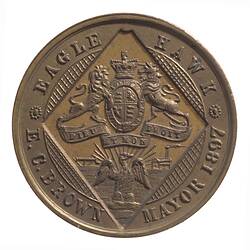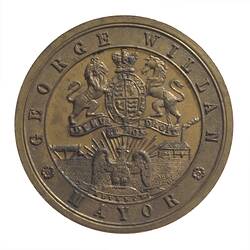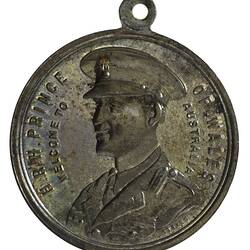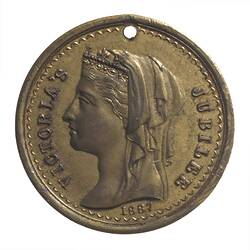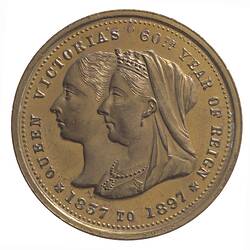Eaglehawk is a hilly district, eight kilometres beyond central Bendigo, with many quartz lodes. The origin of its name is uncertain. It may have been named by a shepherd who killed an eaglehawk which attacked sheep, or by an early goldminer who observed an eaglehawk. Gold was discovered at Bendigo (Sandhurst) in October, 1851, and the gold-bearing land extended several kilometres north-west of Bendigo beyond Eaglehawk. One well-known goldfield was Eaglehawk Gully, dating from 1852.
The community at Eaglehawk soon began to develop. On 29 July 1862 the Borough of Eaglehawk formed and in 1865 a Town Hall opened. By 1871 the population of Eaglehawk was 6,590. In 1887, when George Willan was Mayor, the Borough issued medals for Queen Victoria's jubilee (NU 20204-5 ), and in 1897, when E.C. Brown was Mayor, it again issued medals for Queen Victoria's diamond jubilee (NU 20453). The same year moves began to build a new Town Hall, but it took until 1901 for funds to be raised and construction to be completed.
Further growth occurred in both the community and social institutions, and by 1903 the the population was 8,130. By then Eaglehawk was connected to Bendigo by steam tramway, and boasted post and money order facilities, three banks and a telegraph office. It had 'numerous hotels', three state schools, two private schools, nine churches, a court of petty sessions, a police station, two mechanics institutes, several organised societies and a park 'hansomely laid out with flower beds and shrubs'. The 'model borough' had 1,862 houses, and streets lit partly with gas and partly with kerosene.
By 1947 the decline in gold mining had caused the population to fall to 4,090. Bendigo became more dominant as an employment centre. However, Eaglehawk still had nine hotels and as well had acquired an electric tram and public baths.
The population reached its turn-of-the-century level again in 1991. On 7 April 1994, the Borough of Eaglehawk was united with the City of Bendigo, the Shires of Huntly and Strathfieldsaye, and the Borough of Eaglehawk, parts of the Rural City of Marong, the Shires of McIvor and Metcalf to form the City of Greater Bendigo. By then the borough had become physically joined with suburban Bendigo.
Much of Eaglehawk's historic built fabric has been retained, including a primary school, former Methodist Church and the Town Hall. An annual Dahlia Arts Festival is held in March/April.
References:
Australian Places website, Monash University, http://arts.monash.edu/ncas/multimedia/gazetteer/list/eaglehawk.html Blake, L. (1977). Place Names of Victoria, accessed 21/11/2003.
Wallace, R. (1983). Eaglehawk: A Sketch Book of a Golden Past.
More Information
-
Keywords
-
Localities
-
Authors
-
Article types


